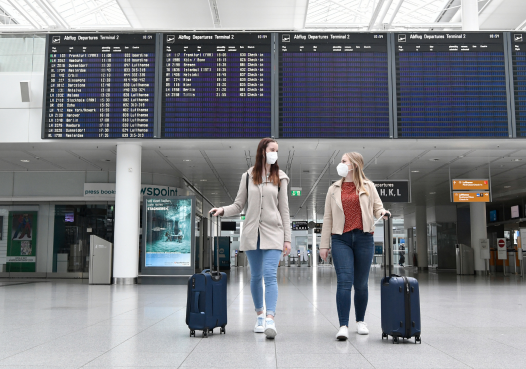Airlines and Airports call on EU/EEA and UK Governments to Immediately Abolish Passenger Quarantines as EASA/ECDC Guidelines Confirm their Ineffectiveness

• EASA/ECDC “Guidelines for COVID-19 testing and quarantine of air travellers1” unequivocally reject quarantines in current epidemiological situation, where transmission of the virus is already widespread.
• Guidelines confirm air travellers account for <1% of all detected COVID-19 cases and do not increase the rate of COVID-19 transmission.
• Aviation associations urge governments to consider rapid testing technologies and success of travel corridors to help restore passenger confidence and support early detection of asymptomatic cases.
European and international aviation associations are urging European governments to immediately abolish quarantine measures and other travel restrictions following new Recommendations published by EASA and the European Centre for Disease Prevention & Control (ECDC), which unequivocally reject their use in the current situation – where transmission of the virus is already widespread.
The EASA/ECDC “Guidelines for COVID-19 testing and quarantine of air travellers: Addendum to the Aviation Health Safety Protocol” also confirm that air travellers account for less than one percent of all detected COVID-19 cases and do not increase the rate of virus transmission.
“These Guidelines unequivocally show quarantines to be essentially politically-driven, non-risk-based measures which bear no relation to what is actually needed to safeguard public health. As such, quarantines fail the test of proportionality, a key principle of EU law – particularly since there are no equivalent measures at land borders. This has resulted in unprecedented limitations to the freedom of movement and the freedom to provide services. We call on national governments to immediately abolish their quarantine restrictions and restore freedom of movement for European citizens”, said Olivier Jankovec, Director General of ACI EUROPE.
A more harmonised, coordinated approach among EU, EEA and UK States is essential to increase clarity and predictability for citizens and businesses following the latest recommendation2 of the EU Council. This is essential for the recovery of the sector.
The EASA/ECDC Guidelines consider 14-day quarantines to be effective only in the “exceptional situation” where a country has achieved full control over the virus and reduced transmission levels to close to zero, and only then for travellers entering from countries where the virus keeps circulating.
Apart from the data presented by the Guidelines, several other analyses confirm the absence of a correlation between passenger traffic and prevalence rates at national level:
- ACI EUROPE’s analysis of airport passenger data in the third quarter of 2020 unequivocally rejects any relationship between air travel and increasing COVID-19 transmission rates. The brief increase in air passenger traffic during this period was proven to have no statistically significant relationship with the COVID-19 test positivity rate, based on aviation, public health and community mobility data. ACI EUROPE’s paper can be found here.
- Similarly, Oxera’s study3 confirmed that the risk of introducing infections from international travel should be assessed relative to domestic infection levels. It projected that among weekly incoming passenger volumes of 409,800 from the EU to the UK, only 0.01% of air travellers were expected to be infectious travellers being released into the UK population. This is the equivalent of one infectious person per 10,000 travellers.
- McMaster HealthLabs in Canada has also published its interim report on their COVID-19 study of arriving international passengers, which again backs up the figure of 99% of passengers testing negative. This, says the labs, is a powerful tool to make “science- based policy decisions” and reject quarantines as a relevant approach to containment. Airlines and airports continue to believe that rapid testing of passengers travelling between high and low-risk areas can contribute to and support the early detection of cases amongst asymptomatic travellers.
European air passenger traffic has been among the most heavily impacted of any region, and recently plunged to -89% at EU/EEA/Swiss & UK airports. To-date, 102 airports across Europe accounting for 47% of passenger traffic on the continent have deployed testing facilities under the supervision of their competent health and aviation authorities. These testing facilities have allowed a number of airlines and airports to propose “COVID-19 free flights” and quarantine-free travel corridors on certain air routes, including most recently between Italy and the United States, based on a testing protocol for air travellers. This proves the all-important role that testing can play in re-establishing connectivity.
“Rapid testing which utilizes the latest technologies available and meets the high sensitivity and sensibility criteria established by ECDC can help restore predictability, reignite passenger confidence and thus reestablish flight connectivity for European passengers”, said Thomas Reynaert, Managing Director, Airlines for Europe (A4E).
Europe’s aviation associations urge European States to work together bilaterally to replicate such initiatives and develop more quarantine free travel corridors.
“Testing technologies are evolving quickly, and we stand ready to work with EASA, the ECDC and national governments to implement the most efficient and effective methods to get Europe moving again”, said Montserrat Barriga, Director General, European Regions Airline Association (ERA).
“Rapid testing of passengers for COVID-19 opens the door to restarting air travel by eliminating quarantine. And the public agrees: Some 65% of travelers surveyed suggest quarantine should not apply to passengers who have tested negative. The EASA/ECDC protocol makes it clear that quarantine is not an effective measure in the present circumstances. And it is important that the protocol should also be applied to remove the temporary travel restrictions on non-essential travel into the EU from third countries”, said Rafael Schvartzman, IATA’s Regional Vice President for Europe.


